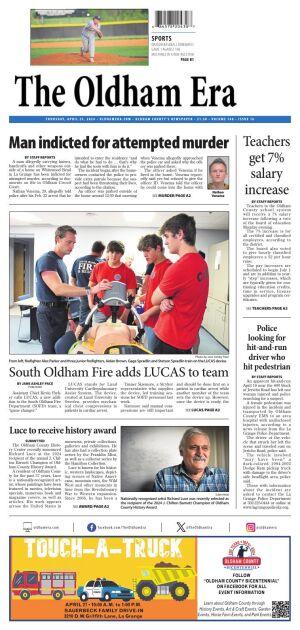On Saturday, it came into clearer focus that residents had dodged a windy bullet. The National Weather Service upgraded its initial evaluation of the tornado that tore through the Buckner area of Oldham County to an EF-2, with wind speeds of 115 miles per hour. The tornado through Prospect had already been upgraded to an EF-2.
Oldham County Dispatch Director Bo Glass said he wasn’t sure what the day had in store on April 2. It initially looked to him like much ado about nothing.
“I watched the weather all day, different outlets,” Glass said. “It was like, ‘Where are the storms?’ ”
But suddenly, the calls started coming, to the point of overwhelming, and it came into focus that dispatch itself could be in the path of the tornado.
“It was a little scary,” Glass said. “We knew it was in the area.”
Glass warned his staff of the risk, expecting they might need to seek shelter themselves in the next moment.
“They just continued to work,” he said.
Staff had limited visibility into what was brewing outside. Because of the information they handle, dispatch centers are required to have significant window tinting, per Federal Bureau of Investigation requirements, Glass said.
“Your visual is based on the calls you’re getting,” he said.
Glass complimented his staff, who handled an overwhelming number of calls from residents and first responders, even as they learned their own families were in potential peril. He said it was 90 to 120 minutes of non-stop incoming and outbound calls and coordinating responses. He considers his staff invisible heroes, because they help so much but aren’t seen by the public in person the way first responders are on the scene.
“I couldn’t be more proud,” he said.
Zack Wilt, Oldham County’s emergency management administrator, found himself handling his first major emergency just six months into his new job.
“It’s been a learning experience, that’s for sure,” said Wilt, who previously served as volunteer deputy director.
One of his many concerns on Tuesday was a major gas leak at Stonefield Trace, where a cul-de-sac required evacuation.
Stonefield Trace residents are largely back in their homes, but six or seven houses remain uninhabitable, he said.
He believes 40-50 houses in the county were damaged, 10-15 power poles were down and 200 trees were toppled. No injuries were reported in Oldham, Jefferson or Henry, but he said he did hear of a close shave.
Wilt says he heard a story of a man who had been mowing until the last possible minute and had to jump into a ditch to escape the tornado.
“He wanted to finish the yard and waited just a second too long,” he said.
Wilt said it often happens that way, that people linger outside or by windows, anxious to see what’s coming. That curiosity is tough to overcome.
“It’s a Kentucky thing,” he said.
To call or not to call? Dispatch Director Bo Glass says it’s not a matter of if you should call, but who you should call. “I never want to give the impression of ‘don’t call,’ ” he said. Glass says 911 is the right call for anything involving smoke, fire or injury. A power line might seem like a major emergency in the making, but if a line is down and not smoking, it can be called into the office’s administration line, which is (502) 222-0111. A non-smoking downed power line is still important and requires a call, but it is less imperative and can be handled on the administrative line. {related_content_uuid}948c211d-b62c-4ddc-8130-e48812f0b31c{/related_content_uuid}













